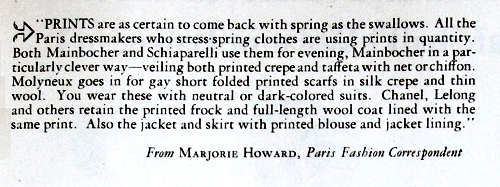Thanks to Monica Shaffer and her colleagues at the Panhandle-Plains Historical Museum in Canyon, Texas, I can share some images from Butterick Fashion News, August 1938. It features this shirt and slacks combination on its cover:

Butterick pattern 7988, August 1938. A “bush jacket” on the cover of Butterick Fashion News flyer.

Back view of Butterick pattern 7988, dated August 1938. “The Bush jacket is a new companion for slacks.” The back shows a pleat and gathers for ease of movement.
This “bush jacket” pre-dates the 1967 YSL safari collection — a lasting fashion influence — by nearly thirty years.
The Panhandle-Plains Historical Museum is “located just a few miles from Amarillo as well as Palo Duro Canyon,” which could be a pleasant side trip if you are headed toward North Texas. I’d be a happy traveler in that pants outfit.
This pleated bolero jacket looks fresh, seven decades later…. Here’s a link to a more recent one by Alaia, on sale for $3,000.

Butterick bolero and dress No. 8005 and a dress with waist-length jacket, No. 8017. 1938.
I also like the way the open fronted, waist-tied jacket on the right allows a row of buttons to peek through.

Butterick patterns 8005 and 8017, from summer, 1938.
I had never heard of “the Doll Silhouette,” which makes the skirt ripple by stiffening the hem.

The Doll Silhouette; Butterick patterns 8023 and 8016. August, 1938. Lots of top-stitching. “By stiffening the hemline, even the limpest fabrics flute out like the dress of a doll.” [Or an Art Nouveau illustration.]
Butterick 8023: “Grosgrain ribbon swirls out the hemline, ties the neck.” Sizes 12 to 20; 30 to 44 [bust measures.] Butterick 8016: “Organdy is stitched inside skirt and shoulders, waist is pulled in.” Sizes 12 to 20; 30 to 40 [bust measures.] All those
lines of parallel stitching remind me of the
same ornamentation in 1917-1918.
Sheer dresses, like these, featured in 1938…

Sheer dresses: Butterick 8011 and Companion-Butterick pattern 7989. August, 1938.
… and were also on the cover of the Butterick Fashion News –and in many other pattern catalogs — in 1939.
The Doll Silhouette was also mentioned with Butterick 8020.

Butterick patterns 8020 and 7993, August 1938.
Here is the whole page:

“Swing Your Skirt Wide.” A page from Butterick Fashion News, August. 1938.
Hemlines are rising, but, even on younger women, they are still well below the knee. Here is a closer view of the two outfits on the right:

Dresses for younger women, Butterick, 1938. Patterns no. 7999, a two-piece, and 8022. I love the sporty vest or “weskit” illusion.
Butterick 7999: “Two-piece, two-tone dress.” Sizes Junior Miss 12 to 20, bust measurement 30 to 38 inches. You can see a less casual version on the pattern envelope at the Vintage Pattern Wikia.
Butterick 8022: “A gored skirted dress designed to make you look taller.” “For Misses of 5 ft. 4 or under in sizes 12 to 20; 30 to 40” [bust measure.] Is “taller” a euphemism for “thinner?” If so, the center back seam on the skirt is a good idea.

Butterick Fashion News, page 5, August 1938. Companion-Butterick patterns 7991 and 7987; Butterick patterns 8007 and 7995.
Another sheer dress, and some lively prints. I’ve written about the popularity of large-scale prints in 1938 before. Companion-Butterick patterns were featured in Woman’s Home Companion magazine.

Additional lively prints were shown on the back cover:

Print dresses from Butterick patterns 8003 and 8009, Aug. 1938.
Butterick 8003: “In the manner of Vionnet, with draped shoulders, wide short sleeves.” Sizes 12 to 20, 30 to 40 [bust.]
Butterick 8009: “A sheer printed cotton looks very youthful gathered at the neck and sleeves.” Sizes 12 to 20, 30 to 40 [bust.]
When a style is described as “youthful,” I always suspect that it’s aimed at older wearers — although this pattern isn’t available in larger sizes.
Here are styles for “figure problems.”
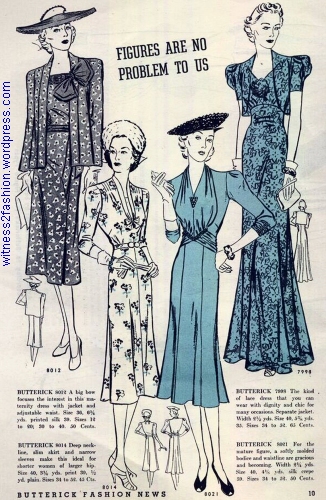
“Figures are no problem to us.” The problems range from wide hips to pregnancy.
The suit dress on the left is a maternity outfit:

Butterick 8012, (top left) August 1938. A wide bow at the neck is meant to distract from a pregnant body. (Not that this model is “showing.”)
Butterick 8012: “A big bow focuses the interest in this maternity dress with jacket and adjustable waist.” Sizes 12 to 20, 30 to 40 [bust measurement.] See the dress on its envelope here. The “wrap” maternity dress has a deep pleat at its left side for expansion.

Butterick 8014 (left) for “shorter women of larger hip,” and Butterick 8021 “for the mature figure.” 1938.
Butterick 8014: “Deep neckline, slim skirt and narrow sleeves make this ideal for shorter women of larger hip.” Sizes 34 to 52 [inches bust.]
Butterick 8021: “For the mature figure, a softly molded bodice and waistline are gracious and becoming.” Sizes 34 to 52 [inches bust.]
Butterick 7998 is a simple lace evening dress that “you can wear anywhere with dignity and chic;” its bolero jacket covers the upper arms. This gown was available in bust sizes 34 to 52 inches. [And illustrated on a size 34, of course.]

Butterick 7998 evening dress with jacket for mature women. Aug. 1938. Available in large sizes.
I’ll try to share more of these great thirties’ clothes in another post. Thanks again to the Panhandle-Plains Historical Museum.









































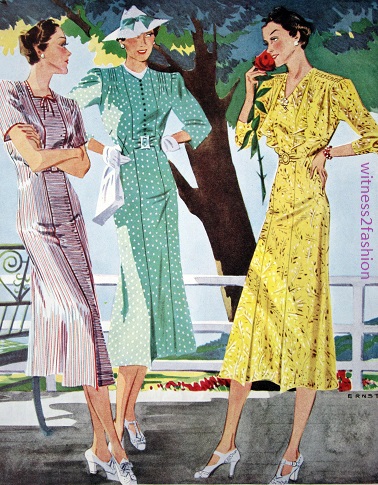



























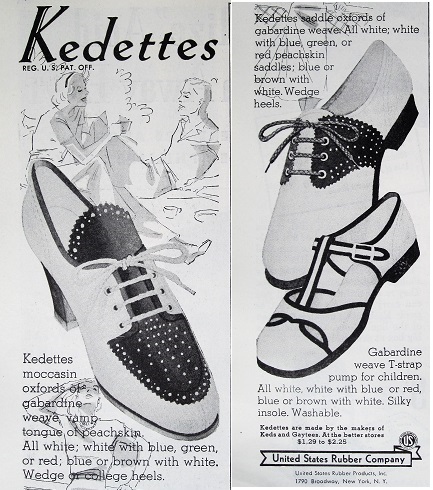
























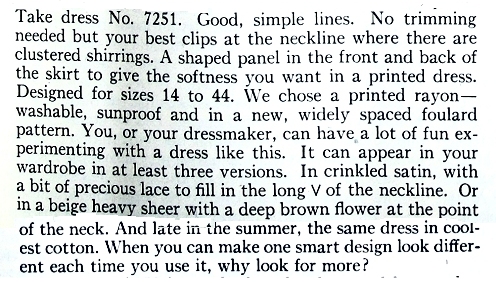



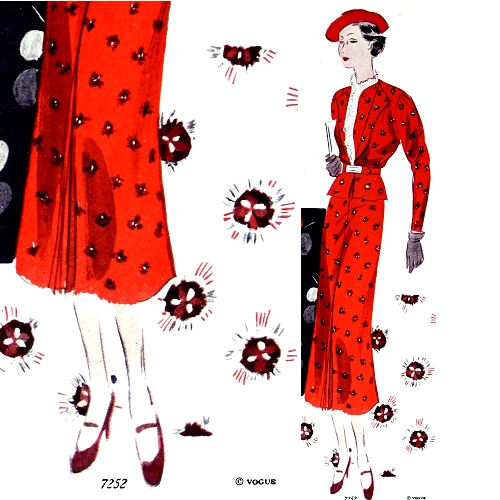








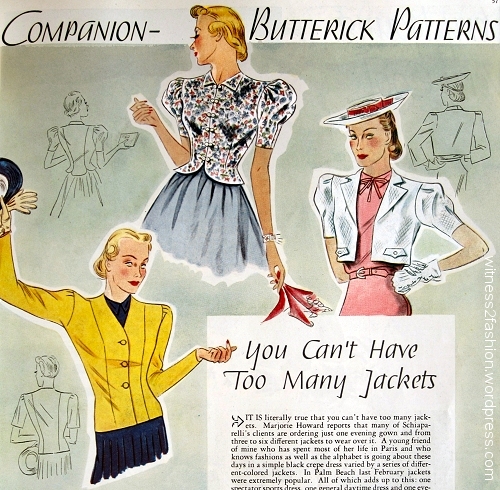





















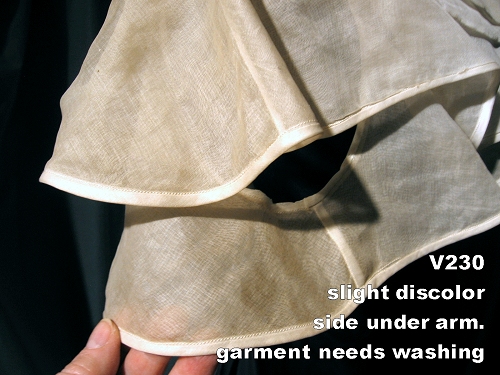



















!["7079 Dress. Sizes 12 to 20; 30 to 44 [inch] bust measure." Companion Butterick, Nov. 1936.](https://witness2fashion.files.wordpress.com/2015/11/whc-1936-nov-p-82-triad-7079-three-generations-500-daughter.jpg?w=500)














